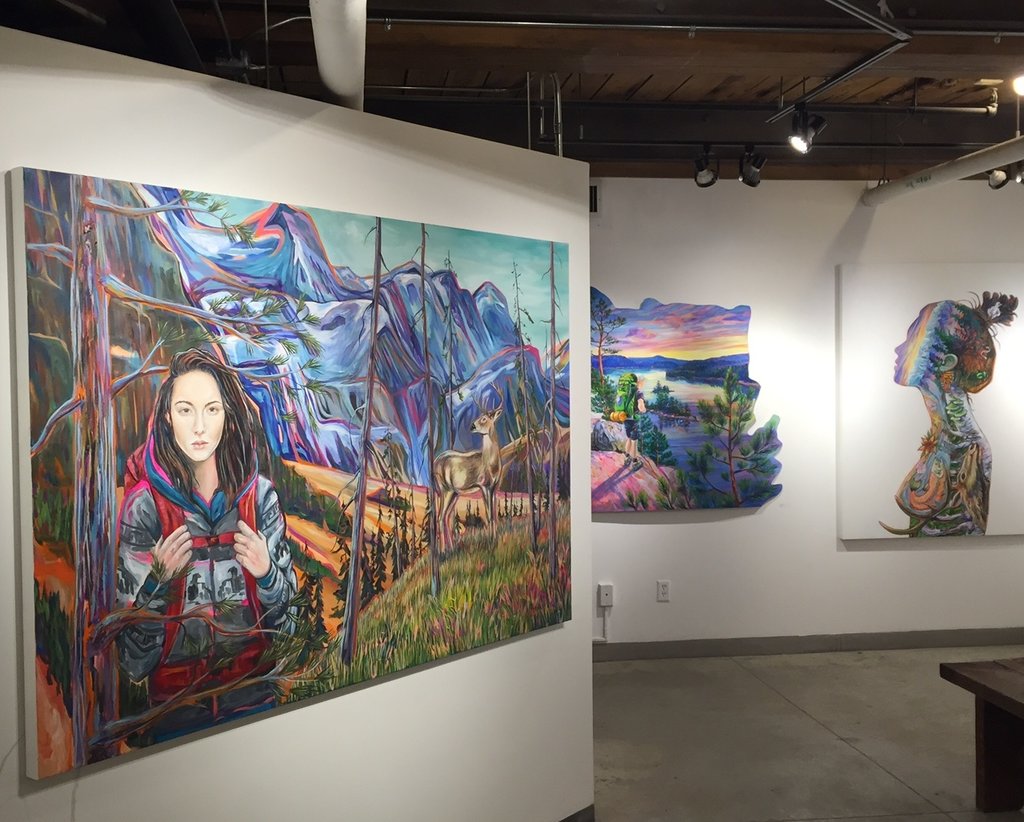ReWilding, an exhibition of large-scale paintings by Sarah Carlson at Graven Feather, encourages us through personal mythologies to re-imagine and re-visit our wild roots. Sarah Carlson’s nostalgia-inducing topographical scenes of Canadian landscapes reposition our figurative human form to forge a deeper, tenderer connection with nature. Some of the landscapes were captured en-plein-air during her ten-day residency in Algonquin Park. Given this experience, it is not difficult to discern a familiar romanticization of nature not unlike Carlson’s Canadian outdoor-painter predecessors. The painting “Save Wolf Lake” (2016) of a hiker overlooking a lake is of particular importance as the site of Wolf Lake is in danger of excavation, and the title operates as a call for action. The work on cutout reclaimed wood board presents a moment of serenity at risk of being lost.
 Sarah Carlson in front of Save Wolf Lake, 48 x 48”, acrylic on wood (left) and Biologique, 60 x 48”, acrylic on birch (right). Photo: Alice Pelot
Sarah Carlson in front of Save Wolf Lake, 48 x 48”, acrylic on wood (left) and Biologique, 60 x 48”, acrylic on birch (right). Photo: Alice Pelot
Carlson’s paintings are not only representations of her direct experience in wilderness; she also captures a Narnian environment for the intimate and spiritual co-habitation of humans and animals. The five large acrylic paintings glow with a vibrant orange and pink base layer like the highlighter pink accents in the paintings of her contemporary Kim Dorland. It is this use of synthetic colours, combined with topographical imagery that reveals Carlson’s personality and emphasizes in her practice a balance between self and nature. Among all the colourful, dynamic, wispy brushstrokes, the multiple layers of landscape are still discernible, each has its own bright tone and successfully demonstrates a skillful landscape painting technique. In addition to the paintings, Carlson has chosen to exhibit a sculptural wall-hanging work titled “Connected”(2016). It is composed of a think slice of a found, hollow tree trunk including rings, insect markings and fungus. Inside this wooden ring are small quartz strung on wire and stretched across like a dream catcher. Behind the wood, reflecting off the wall, is a colourful diode light perfectly complimenting Carlson’s painting style in which synthetic colour highlights and vaguely outlines natural forms.
 Sarah Carlson, Last Child in the Woods, 48 x 48”, oil and acrylic on birch. Photo: Alice Pelot
Sarah Carlson, Last Child in the Woods, 48 x 48”, oil and acrylic on birch. Photo: Alice Pelot
 Sarah Carlson, Rewilding, 48 x 72, acrylic on canvas. Image courtesy of Graven Feather
Sarah Carlson, Rewilding, 48 x 72, acrylic on canvas. Image courtesy of Graven Feather
Carlson describes the scenes as “environments for both human and non-human animals.” She does not separate ‘human’ as the civilized from ‘animals’ as the barbaric. Instead, the wild landscape levels the field of existence and vulnerability, evidenced in her paintings by the pairing of figure with animal such as a wolf, deer and bear (bringing to mind the tradition of spirit animals). In Carlson’s self-portrait titled “Biologique” (2016), we get a sense for her personal connection to nature and wilderness. A bird nests in her hair which is portrayed as tree roots, her face is metaphorically painted in the clouds, her ear echoes the shape of mushrooms, her ribs are composed of tree branches and an antler, she is fully integrated with the landscape. In this version of nature, so thoroughly blurring the lines between human and non-human, Carlson highlights how we (humans) seem more vulnerable to a fate linear to natures.
 Installation view with Sarah Carlson’s paintings (from left to right:) Corridor, 48 x 72”, acrylic on canvas, Save Wolf Lake, 48 x 48”, acrylic on wood and Biologique, 60 x 48”, acrylic on birch. Photo: Alice Pelot
Installation view with Sarah Carlson’s paintings (from left to right:) Corridor, 48 x 72”, acrylic on canvas, Save Wolf Lake, 48 x 48”, acrylic on wood and Biologique, 60 x 48”, acrylic on birch. Photo: Alice Pelot
Alice Pelot
*Exhibition information: April 6 – May 1, 2016, Graven Feather, 906 Queen Street West. Gallery hours: Thur – Sat, 12 – 7 p.m.
